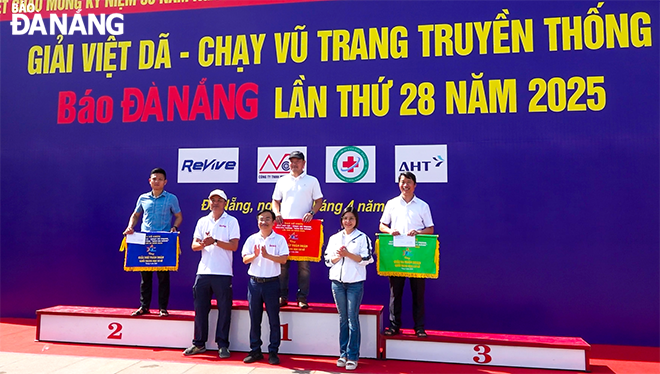Da Nang and its aspiration to rise
After half a century of accompanying the nation on its journey, Da Nang is now preparing to step into a new era of national advancement. This new era of development naturally brings with it new demands and challenges. Therefore, to confidently move forward alongside the country in the future, Da Nang must undertake a comprehensive review of its resources and strategic assets.
 |
| A corner of Da Nang seen from above. Photo: DANG MINH TU |
First and foremost, a new era of development requires each locality to possess a strong and substantive capacity for international integration. Over the past half-century, especially since becoming a centrally governed city, Da Nang’s ability to integrate globally has been increasingly recognized. In terms of air transportation, Da Nang International Airport is the country's third international airport.
Regarding maritime transport, Da Nang Port has transformed into the largest seaport in central Viet Nam, playing a crucial role in the logistics supply chain along the East-West Economic Corridor (EWEC). It also serves as a key link in the regional connectivity network.
Da Nang’s capacity for international integration is particularly evident in its role as a host for key diplomatic events of national significance. When Hanoi hosted the APEC Economic Leaders’ Week in 2006, Da Nang—alongside Hoi An—was selected as the venue for the Third APEC Senior Officials’ Meeting (SOM III). This event laid the groundwork for Da Nang to once again take center stage when Viet Nam hosted APEC 2017, culminating in the APEC Economic Leaders’ Week held in the city.
Furthermore, Da Nang's international integration capability is reflected in the government's decision to establish a Regional Financial Center and a Free Trade Zone linked to Lien Chieu Port starting in 2025. Clearly, this serves as a key asset that enables Da Nang, as a centrally governed city, to confidently advance alongside the nation in this new era of development.
Another essential asset that cannot be overlooked is cultural heritage—a form of "soft power" that is not only placed on equal footing with economic, political, and social development but also, as President Ho Chi Minh emphasized in late 1946, must "light the way for the nation". Over the past half-century of accompanying the country’s progress, Da Nang has left a significant mark in preserving and promoting the rich cultural heritage of Quang Nam.
The city is home to the Marble Mountains (Ngu Hanh Son), a nationally recognized special monument located by the East Sea, featuring the Vong Hai Dai stone stele and an extensive collection of ancient inscriptions carved into the mountain cliffs. Other notable landmarks include the Dien Hai Citadel, also a nationally recognized special monument; the Museum of Cham Sculpture; the Hoang Sa Exhibition House; the Da Nang Museum; and the internationally acclaimed My Khe Beach, often listed among the world’s most stunning shorelines. Additionally, Da Nang has built a cultural brand through signature events such as the International Fireworks Festival and the Da Nang Asian Film Festival. These are some of the cultural strengths that Da Nang has strived to promote over the past decades to affirm the brand of the city by Han River.
Of course, Da Nang’s greatest strength over the past half-century of accompanying the nation’s progress lies in its people and their signature "smile"—a brand not only of warm hospitality extended to visitors from all over but also of the genuine camaraderie shared among locals. This spirit of unity has been the foundation of the city's collective strength for decades. City leaders have repeatedly emphasized that Da Nang’s most valuable achievement is winning the hearts of its people.
It can be said that policies centered on the people—serving them, staying close to them, and striving for their well-being—have consistently earned widespread public support. In Da Nang, the phrase "The Party speaks, the people trust; the Front and mass organizations mobilize, the people follow; the government acts, the people support" is not just a slogan but a lived reality. As the city enters a new era of national advancement, Da Nang continues to strengthen this foundation of social consensus. More importantly, it must strive to secure a firm position in the hearts of its people—because there is a vast difference between winning public support, not losing the hearts of the people and truly having a position among the people.
Notably, as the nation stands on the threshold of a new era of advancement, Da Nang’s three key assets—its capacity for international integration, its cultural values, and its strength in social consensus—are further amplified within the broader national context. This comes at a time when the central government is undertaking administrative mergers across provinces and cities to expand development opportunities.
It is clear that the most vital asset for Da Nang, as a centrally governed city, in its long march alongside the nation into this new era of growth is its collective memory—not just of the past 50 years since the country’s reunification, the North and the South reunited, but also of a time of hardship and heroic struggle against foreign invaders. This historical resilience was recognized as early as 1946, when Da Nang’s battlefield was praised as “one of the strongest and most enduring in the country,” and again in 1967, when Quang Nam was honored as “valiant and steadfast, leading the fight against the Americans”.
To live with memory, to cherish, inherit, and elevate the remarkable qualities of Da Nang’s people from the past is an essential foundation as the people of Da Nang in particular, and Quang Nam in general, step into a new era of development. Standing at this threshold, they must envision and shape the identity of Da Nang’s people as remembered in history. More importantly, they must determine how this historical identity can continue to walk alongside the present—because, as a philosopher once emphasized, “The present of what has passed is memory, and the present of what is to come is anticipation; both memory and anticipation are events that belong to the present.”
Reporting by BUI VAN TIENG – Translating by HONG VAN








